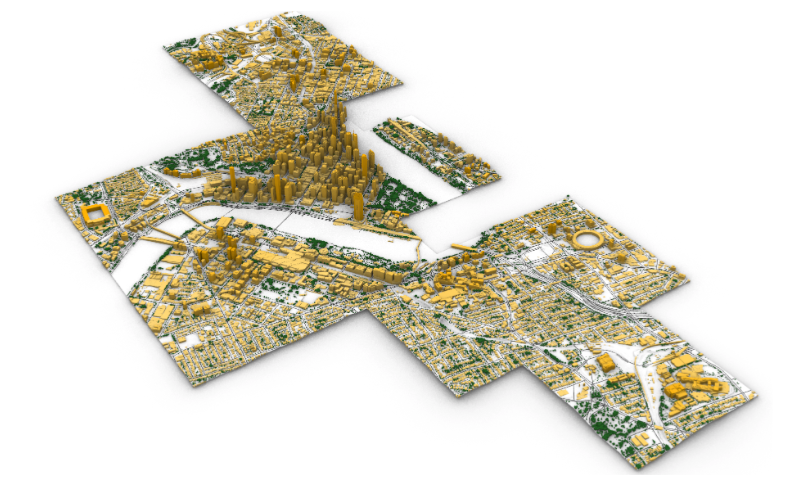The sustainable energy alternative, Wind Turbines, are often used in areas of wide open space to generate large amounts of electricity.
Some suggested visual impact mitigation options include the re-siting of turbines to other locations, re-sizing of turbines and other alterations, re-colouring and vegetation screening.
Re-siting
The results of a viewshed analysis study will determine whether wind turbines should be relocated in order to achieve a lesser visual impact. This should be assessed during the preliminary design phases, with a series of layout options that have different visual impact outcomes and remain viable for wind energy generation.

Re-sizing
Perhaps the scale of the proposed wind energy development facility could be reconsidered. This could mean changes to the size of the relevant roads, buildings, electricity transmission terminals, distribution electricity power lines and poles or underground cabling. Typically this is resolved with one of these two methods:
- Using wind turbines or other structures that are of a lesser height or size in order to reduce their relative visual magnitude within the distance that they are viewed from critical viewpoint
- Substituting larger wind turbines (that generate more electricity) or other structures for a significantly higher number of smaller wind turbines or other structures. This option may be useful where the sheer number of alterations spread throughout a landscape or extended horizontally across views or across key features such as ridge lines may create a greater visual impact or visual impacts seen from a greater number of viewpoints than would a fewer number of larger alterations.
Likely, a number of factors will have to be considered regarding the resizing of the turbines, including the nature and extent of visual impacts, changing technology and the overall efficiency of the wind energy project.
Re-colouring
Wind turbines and other modifications can be easily identified as changes in the landscape due to their colour contrast with their surroundings. If these changes blended in with the landscape, they would be much harder to spot. The level of visual contrast is determined by the difference in colour and brightness between the introduced object and the background landscape or sky. Humans are more sensitive to contrast than changes in light intensity or luminance.
It is challenging to completely eliminate colour contrast due to the variability of backdrop colours and lighting conditions in the landscape. However, reducing the level of colour contrast can have a significant impact on the negative perception of these alterations on the scenic quality of the landscape.
Wind turbines are typically painted white, which is at the extreme end of the grayscale (0%) and colour brightness scale (100%). Most natural colours found in Australian landscapes and sky occur within the middle range of the grayscale (15% to 60% darkness) and brightness scale (approximately 40% to 85%). By using darker-toned colours on wind turbines, the degree of colour contrast and visual impact could be reduced.
To achieve the maximum reduction in general contrast, wind turbines should have a colour that falls midway between the extremes of colour contrast in the surrounding landscape. However, reducing colour contrast when wind turbines are silhouetted against a changing sky backdrop is a challenging task, as the backdrop colour may change from deep blue sky to white clouds. White colour produces the most extreme contrast in all situations except when the backdrop is white clouds. Therefore, choosing turbine colours that achieve the greatest average contrast reduction under different sky lighting conditions may be a better solution for wind turbines located on ridge tops.

Vegetation Screening
Planting trees and shrubs to visually screen wind turbines or other visual impacts may be an option for specific viewpoints. However, this should not be the first mitigation option considered, as visual impact issues can cause conflicts between the community or residents and the proposed wind energy project. People value landscapes and specific views of the landscape, which can be potentially removed by vegetation screening.
Mitigation using vegetative screening will be subject to further consideration by the consent authority, given the potential loss of views. However, this option can be useful in appropriate situations where residents have requested it. The height of wind turbines compared to surrounding trees means that the vegetation must be relatively close to the viewer to be effective.
In addition to vegetation, the potential loss of existing vegetation should also be considered. Visual screening that was relied upon to reduce visual impacts from wind turbines may be lost due to circumstances such as trees falling over due to ageing, wind storms, being cut down, or burning down in bushfires.
Did you know Certified Energy can provide viewshed diagrams? Our viewshed analysis can be used for projects of all scales. We have comprehensive experience with view shed analysis, survey accurate photomontages, viewpoint analysis, development mitigation, photographic survey, water view & view montage, predictive view montage, council view report, landscape character assessment, viewer sensitivity and LVIA working within the current GLVIA.
Need advice? Feel free to get in touch with us and talk to one of our highly qualified technicians and Architects today.
1800 115 661
info@certifiedenergy.com.au






